Maintaining indoor air quality can be challenging, especially with changing humidity levels. Dehumidifiers and humidifiers are essential for regulating the indoor atmosphere, but they work differently to tackle specific problems. Understanding the differences between these devices is crucial for making an informed choice. A suitable device, such as a dehumidifier to reduce excess moisture or a humidifier to increase humidity levels, can significantly improve your living environment and prevent health and home-related problems.
What Is a Dehumidifier?
Removing moisture from the air with a dehumidifier may be helpful in places with high humidity. A general sensation of stickiness, dust mites, and mold growth are just a few issues that can arise from excessive humidity. By lowering moisture levels, dehumidifiers contribute to the creation of a cozier and healthier interior atmosphere. They enhance the air quality and shield your possessions from the devastation caused by mold and mildew, which may flourish in excessively damp environments. Professional dehumidifier installation services ensure your unit is set up correctly, optimizing its effectiveness and longevity. Experienced technicians can also guide maintenance and usage, helping you maximize your investment in indoor comfort and air quality improvement.
How Dehumidifiers Work
Dehumidifiers function by pulling in moist air and passing it over cooling coils. This process condenses the moisture into water, collected in a tank or drained away. The now-dry air is then released back into the room. This continuous cycle helps maintain optimal humidity levels, ensuring your home remains comfortable and free from excess moisture. This process’s efficiency depends on the dehumidifier’s model and capacity, with more advanced units offering programmable settings and energy-saving modes.
How Does a Humidifier Work?
Conversely, a humidifier adds moisture to the air, ideal for dry environments. Low humidity levels can cause dry skin and irritated respiratory tracts, making you more susceptible to colds and flu. Humidifiers are particularly beneficial during the colder months when indoor air can become exceedingly dry due to heating systems. They help maintain a comfortable humidity level, alleviating many discomforts associated with dry air.
Types of Humidifiers
Humidifiers come in several varieties: steam vaporizers, evaporative, and ultrasonic humidifiers. Each has a different way of moisturizing the air based on the particular requirements of your setting. While evaporative humidifiers utilize a fan to force moisture into the air after a wick filter absorbs water, ultrasonic humidifiers employ ultrasonic vibrations to produce a fine mist. In contrast, steam vaporizers heat water to produce steam, which is cooled and discharged into the atmosphere. The ideal option will rely on your unique demands and the space size you’re seeking to humidify. Each variety has advantages and disadvantages.
Benefits of Using a Dehumidifier
- Prevents mold growth
- Reduces dust mites
- Improves air quality
- Creates a more comfortable living environment
Dehumidifiers are particularly useful in basements, laundry rooms, and other areas prone to high humidity. Reducing excess moisture protects your home and alleviates allergy symptoms caused by mold and dust mites. Additionally, dehumidifiers can prevent the warping of wooden furniture and flooring and the peeling of wallpaper and paint, which can occur in high-humidity environments.
Advantages of a Humidifier
- Relieves dry skin and irritation
- Improves respiratory health
- Prevents dryness in furniture and household items
- Creates a more comfortable indoor atmosphere
Humidifiers can be a lifesaver during winter when indoor air tends to dry out. They help maintain moisture levels, protecting your health and wooden furniture, books, and musical instruments from drying out and cracking. In addition to alleviating dry skin and respiratory irritation, an adequately humidified environment can also reduce the static electricity that often accompanies dry air, making your home more comfortable overall.
When to Use a Dehumidifier vs. a Humidifier
Understanding when to use each device is crucial. Generally, a dehumidifier is better if your indoor environment feels sticky or musty or if you notice signs of mold. Conversely, if your skin feels dry, you experience frequent respiratory issues, or your wooden furniture starts to crack, a humidifier could provide significant benefits. Monitoring the humidity levels in your home with a hygrometer can give you a better idea of which device is needed at any given time.
Seasonal Considerations
Different seasons often require different approaches to maintaining indoor air quality. High humidity levels may necessitate using a dehumidifier in summer to keep your living spaces comfortable. In contrast, a humidifier can be indispensable when heating systems dry out the air in winter. Balancing indoor humidity levels throughout the year can help prevent the health issues and home damage associated with high and low humidity, creating a consistently comfortable living environment.
Energy Consumption and Costs
Both gadgets may impact your energy expenses but in different ways. Because they remove moisture from the air, dehumidifiers often require more energy than humidifiers. Modern versions, on the other hand, are built to be energy-efficient. Conversely, humidifiers often consume less energy but need routine upkeep, including cleaning and filter changes, to function at their best. Dehumidifiers may be more expensive initially and over time, but they can save money in the long run by preventing mold growth and improving air quality. Conversely, humidifiers frequently have cheaper initial costs but may need regular maintenance and filter changes. You may make a better judgment if you weigh each alternative’s long-term costs and advantages.
Conclusion
Choosing between a dehumidifier and a humidifier largely depends on your indoor air quality needs. Both devices offer unique benefits for a healthier, more comfortable living space. By understanding the distinctions and functionalities of each, you can make an informed decision that will significantly enhance your indoor environment. Whether you need to reduce excess moisture or add humidity, selecting the suitable device will ensure your home remains comfortable and healthy.












